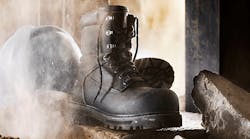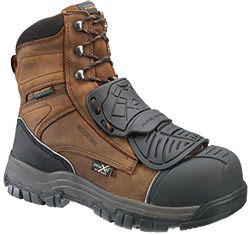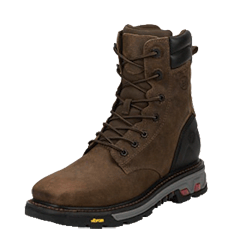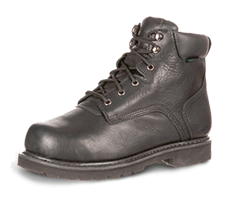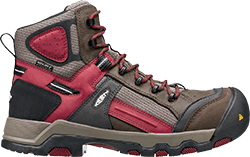Increasingly, as construction industry employers and warehouses hire new workers to meet a rising demand for services, they need to be able to provide their workers with appropriate personal protective equipment (PPE) to help ensure they stay as safe as possible.
According to the National Safety Council, as many as 120,000 work-related foot injuries occur each year, and statistics from the Bureau of Labor Statistics (BLS) indicate as many as half of those injuries result in lost time. Also according to BLS, three-quarters of those injuries occurred because workers were not wearing appropriate foot protection. The National Council on Compensation Insurance estimated the average cost of a lost workday foot injury at more than $9,000.
Many of those can be prevented with the proper work boots.
For many workers, protective footwear is a necessary part of their PPE. But protection only is part of the picture. I should know; I've worked in the construction industry for years and I've gone through a lot of pairs of uncomfortable work boots!
A great pair of work boots plays a crucial role in your employees' health, safety and comfort during the workday, and you need to know exactly what to look for to help them make the best choices. As a safety professional, you don't want to send your workers out onto the floor or to the site without a pair of work boots that are going help prevent injuries. As an employee yourself, you want work boots that are going to make your entire foot feel comfortable and secure throughout the work period. Not every boot can do that, and that's why it's so important to test out different brands and find the boot that fits your needs.
These six tips can help you and your employees choose the best work boots for the job.
Tip #1: Start with Comfort
The first step in choosing a great pair of work boots is to form your opinion about how they feel. Here's a quick test to try so that you don't get overwhelmed in the shopping process:
Select five different work boots of varying price points. Sit down and try each pair on one at a time.
Stand up and walk around, noting how your feet feel in the boot. Note how well your feet and ankles feel supported in the boot. Inspect the boot for extra padding and soft material that adds to the comfort level.
From there, rule out the boots that don't feel comfortable and narrow down your choices to three at the most. This trio will move onto the next round of testing.
Tip #2: Assess Durability
It's important to determine the durability of the boot. If you're working with a sales rep, the person might demonstrate the durability of the boot by throwing it at a wall or down the stairs. He might encourage you to walk around in the boots both inside and outside, so you can see how it transitions to different terrains.
You might even be offered a week to try the boots out so you can see what it feels like to break them in. Take advantage of those offers to test the boots.
Sometimes you can't predict how your new pair of work boots is going to act over their lifetime. The only thing you can do is wait. Since these are work boots, they are going to get scuffed and scratched. What you don't want, however, is for the material to split or sever with minimal use or for the stitching to unravel.
Generally, a good indicator of quality materials and manufacturing is if the manufacturer offers a lifetime warranty. That means the company is standing behind the durability of the boot – and you can count on them to fix the boot or send you a new pair if anything breaks down in your boot over the course of its life with you.
Tip #3: Check for a Steel Toe
If you're working at any site where there is the threat of something falling on or crushing your feet, then you need to make sure your work boots have a steel toe. A steel toe is going to protect your toes and a good part of your foot from getting crushed. These boots are used in many industries including construction, warehousing and material handing and even in commercial kitchens.
If workers need steel-toed work boots, encourage them to try different brands, not just different styles. Different brands approach the design of steel toes differently; some "steel toes" aren't made of steel any longer. Some brands might be more or less comfortable for different employees.
All work boots are rated with special codes to indicate safety standards, such as whether a chainsaw will cut through them or if they protect your soles. You can find an infographic that deciphers the ASTM labels at http://www.aboutboot.com/best-work-boots/ to help you better understand the symbols used to identify the properties of work boots.
The heel of the matter: Don't buy a work boot without a steel toe if you are at risk of dropped objects or crushing injuries.
Tip #4: Determine Whether your Boots Are Waterproof
For workers who will be spending a lot of time outdoors on a construction site or if your area receives a great deal of snow or rain throughout the year, then you probably should check that protective footwear is made from waterproof materials or can be waterproofed using over-the-counter products.
When work boots are waterproof, workers can spend a great deal of time in inclement situations and face whatever the day may hold for them on the job site – snow, rain, mud – without worrying about wet, uncomfortable feet.
Most of us know how annoying it can be to take off work boots once you've gone through the trouble of putting them on and lacing them up. Wearing weather-appropriate footwear and appropriate socks can help avoid having to change shoes or socks because of dampness. Which brings me to the fifth tip…
Tip #5: Consider How Long It Takes to Don and Doff Work Boots
As you continue to test out work boots, give yourself and employees a little challenge that also can be fun; see how long it takes to put the boots on and take them off. That's going to be important to certain industries where time matters; so, you might want to consider Velcro tabs on work boots instead of laces in some cases.
At the same time, you want to be mindful of ankle and feet support in the boots. It's important to make note of that once you've zipped, laced or otherwise secured your feet in the boots. You don't want wobbly ankles or for your feet to slide around.
Tip #6: How Will You Maintain the Work Boots?
We're nearing the end of the selection process. By now, you should have narrowed your choices to one or two selections, and the only thing left to consider is how much time will be spent cleaning the boots.
This may be important to workers who work outside or in conditions in which they encounter dirt and debris. Encourage employees to read the "care" instructions for their boots, as many require special care and products to keep them at their optimal protection level. Depending on the material used to make the boots, they may need to wash, dry and polish fairly frequently.
Going the Distance
Keep in mind that sometimes it takes a little time to find the right match for your feet, because everyone's feet are different – foot width, heel size and arch are just a few ways our feet differ from those of others – and companies design their boots in unique ways to help alleviate some of the common problems associated with work boots.
Are your boots made for walking? Are you ready to put an end to work boots that don't protect you for the work you need to do? Are you tired of callouses and blisters cause by ill-fitting work boots?
Then keep these six tips in mind as you are shopping around. They can help you and your employees start out on the right foot.
Richard Kallis has worked as a construction engineer for last 10 years with various organizations and runs a web site named www.aboutboot.com/, where he talks about foot safety and PPE.
Here is a sample of foot protection products.
